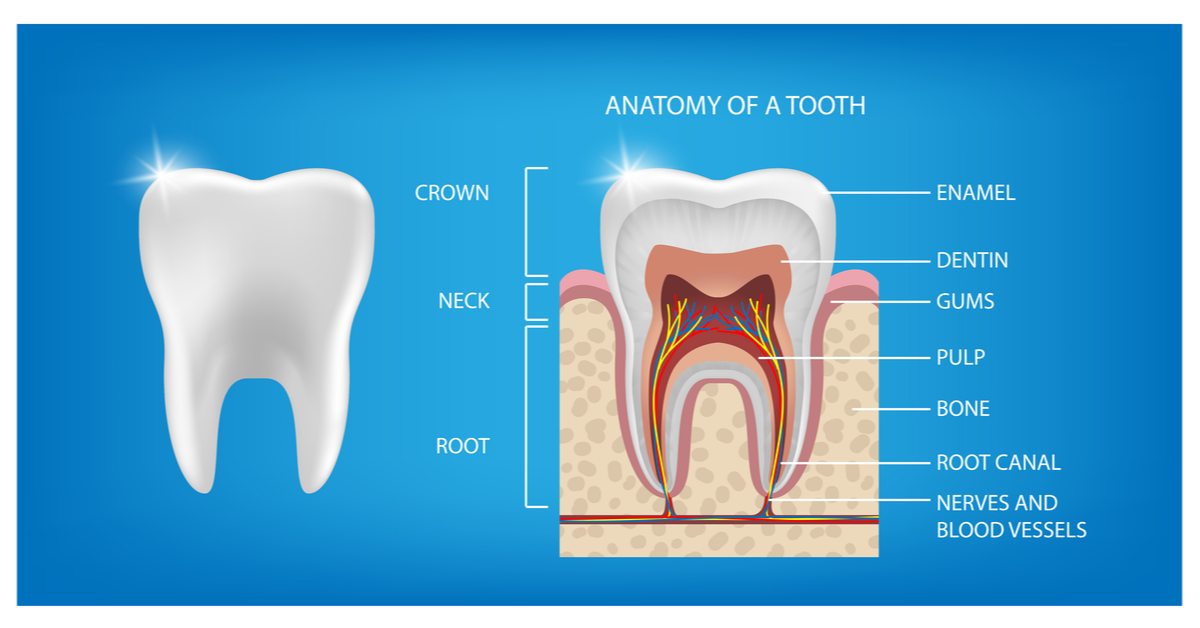
Your teeth may look like they are all one piece, but in reality, teeth are made up of multiple layers. From the crown of your teeth to the nerves inside that tell you when your ice cream is chilly or how to move your tongue to make different sounds, the parts of your teeth work together to allow you to do many things.
To help demystify your teeth, our Billings, MT dentists here at Bridge Creek Dental are here to cover tooth anatomy and clear up what the basic parts of your teeth are and what they do for you.
What Are The Part Of A Tooth
The basic parts of a tooth consist of the crown, enamel, dentin, tooth pulp, and root. Each plays an important role and needs to be taken care of to ensure a healthy smile.
Crown
Top of the tooth, the crown is the part of the tooth, which makes the most contact with your other teeth and the objects you bite. With this constant contact, the crown of the tooth is vulnerable to becoming worn down and damaged, particularly if the crown makes contact with something hard.
While some wear is expected, when a crown becomes chipped or cracked, a dental filling or dental crown is needed to keep your tooth protected.
Enamel
The hard, white outer layer of your teeth is called the enamel. Your tooth enamel is the hardest substance in your entire body, which the enamel has to be to stand up to decades of heavy usage. It also protects the softer, more sensitive layers of your teeth. With proper dental hygiene, you should be able to maintain the enamel of your teeth for years to come.
When the enamel of your teeth is breached by bacteria, it forms a cavity. If dealt with quickly, all you need is a dental filling to re-seal your tooth. However, if it is left unaddressed, your enamel can suffer further damage, and the tooth layers below can be jeopardized.
Dentin
Directly below the enamel layer of your tooth is a layer of dentin. This layer of your tooth is yellow, and when your enamel layer is thinner, the yellow you see in your teeth is likely the dentin showing through. The dentin helps support the enamel—but it is not as hard—and is the last layer of defense for the pulp of your teeth.
If the dentin is breached, you are lucky if all you need is a filling. Because, once tooth decay has made its way completely past the dentin, you will need a root canal to clean out the problem.
Tooth Pulp
Your tooth pulp is where all the soft tissue—nerves, blood vessels, etc.—of your tooth are located. This collection of tissue is what allows you to feel when your teeth make contact with something, changes in temperature, and pain when there is something wrong with your teeth.
If tooth decay allows an infection to set into the tooth pulp, it can be incredibly painful. A root canal to clean out the infection and a dental crown are generally needed if something goes wrong with the tooth pulp. Left untreated, tooth pulp can die, resulting in tooth loss.
Root
The base of your tooth is the root. This part of your tooth connects it to your jawbone, keeping your tooth in place while chewing, speaking, etc. The pulp of your teeth run through the roots of your teeth and keep the connection between your teeth and your jaw alive.
How To Best Protect Your Teeth
To protect your teeth—from the crest of the crown to the tip of your roots—there is some preventative dental care you should be doing.
- Daily oral hygiene – Your day-to-day oral hygiene routine is the most important thing you can do to maintain your dental health. Be sure to brush your teeth twice a day—morning and night—and floss once a day.
- Fluoride treatment – Provided by our dentists, a fluoride treatment can add extra protection for your teeth, especially if you don’t normally drink water with fluoride in it.
- Regular dental cleanings – Coming in twice a year for dental cleanings is an important part of maintaining your teeth’s health. With regular cleanings, our dental staff can monitor potential trouble spots and catch issues before they become serious problems.
- Dental sealants – If you have deep grooves or crevasses in your teeth, these can allow pockets of bacteria to hide and flourish. To fill in these crevices and protect your teeth, our dentists can apply a thin coat to your teeth, sealing them.
- Nightguard – For those individuals who tend to grind their teeth or clench them at night, a nightguard can be an excellent way to protect your teeth from excessive wear and tear.
When you are ready to schedule your dental cleaning to help protect your teeth, feel free to contact us so that we can get you in as soon as possible!